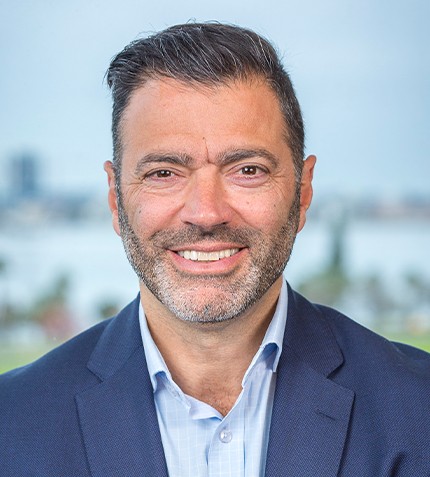
"The pandemic has catalysed transformation in the maritime sector through digitalisation and decarbonisation."
Kenneth Lim
ASSISTANT CHIEF EXECUTIVE (INDUSTRY), MARITIME AND PORT AUTHORITY OF SINGAPORE
How has Singapore evolved as an international port?
Singapore has come a long way from the early days when it had about 20 international shipping groups on its shore. Today, Singapore’s maritime vibrant ecosystem consists of over 170 international shipping groups and a diverse range of maritime service providers. In 2021, Singapore surpassed its pre-pandemic container throughput and recorded 37.5 million TEUs to retain its position as the world’s busiest container transhipment port.
As the world’s leading bunkering hub, the Maritime and Port Authority of Singapore (MPA) continues to work in close partnership with the industry and stakeholders to enhance Singapore’s bunkering services, standards, security and transparency. In 2021, bunker sales of conventional and liquefied natural gas exceeded 50 million tonnes.
With more than 4,000 ships aggregating over 93 million gross tonnage, the Singapore Registry of Ships continues to rank as one of the top five ship registries globally, reflecting Singapore’s reputation as a quality flag of choice for international ship owners. It was also the first ship registry in the world to introduce “smart”, “cyber”, “welfare” and “green” notations for vessels in November 2021 to help ship owners enhance their commercial attractiveness.
Could you highlight the most recent milestones and developments at MPA?
The pandemic has catalysed transformation in the maritime sector through digitalisation and decarbonisation. To help maritime companies get started on their digital journey, MPA has developed a Maritime Digitalisation Playbook (MDP) with the Singapore Shipping Association (SSA) and stakeholders in the maritime innovation ecosystem. Incentives are also provided to encourage maritime SMEs to embark on their digitalisation transformation. To ensure that digital solutions are accessible by SMEs, the Sea Transport Industry Digital Plan (IDP) provides co-funding to support the adoption of pre-approved solutions.
A key aspect of the ecosystem-based approach to innovation is collaboration with stakeholders on common challenge statements. This is done through the annual Maritime Innovation Challenge, a process that brings together maritime corporates and thought leaders to identify impactful real-world challenges.
To streamline port clearances and reduce administrative overheads, MPA launched digitalPORT@SGTM in 2019 and worked with port authorities, maritime administrations, port operators and shipping companies to consolidate 16 different forms across multiple agencies into a one-stop digital clearance platform. It has allowed us to move to paperless and contactless port clearance parts, and save an estimated 100,000 man-hours for the industry each year.
MPA also established digitalOCEANS™ together with global partners, to build upon the IMO Compendium on Data Set and Reference Data Model and jointly develop standard API specifications for port clearance applications. This will enable digitally connected ports, by supporting the implementation of port call optimisation by port authorities and facilitating greater interoperability between digital platforms.
More recently during Singapore Maritime Week 2022 (SMW) which was organised by MPA from 4 – 8 April 2022, the Maritime Singapore Additive Manufacturing Landscape Report was launched to provide a roadmap for companies to experiment with new practices in additive manufacturing.
How is MPA contributing to the development of a skilled workforce for the maritime sector?
We must prepare our maritime workforce for tomorrow. Our seafarers will need to use digital platforms and operate IoT systems onboard future vessels, and would need to handle future marine fuels. The Centre of Excellence for Maritime Safety at Singapore Polytechnic has developed innovative training techniques using artificial intelligence and virtual reality, allowing trainees to undergo realistic training while evaluating their performance more holistically.
The same can be said for shore-based roles. To help optimize manpower deployment, improve productivity and transform ways of working, MPA and Singapore Maritime Foundation (SMF) are embarking on a Job Redesign Pilot Project, focusing on key maritime job roles such as vessel operators and technical superintendents for a start. Companies that can stay ahead of the curve in upskilling their workforce and redesigning jobs, could find themselves attracting the lion’s share of talent.
Launched in April 2022, the refreshed Sea Transport Industry Transformation Map (ITM) aims to develop Singapore into a global maritime hub for connectivity, innovation and talent. On the jobs and skills front, it will focus on developing a future-ready maritime workforce equipped with global skillsets.
MPA set up the Global Centre for Maritime Decarbonisation in 2021. Could you comment on the role of this centre?
The Global Centre for Maritime Decarbonisation has the mission to help the maritime industry eliminate GHG emissions by shaping standards, deploying solutions, financing projects and fostering collaboration across the sectors. We are exploring with the industry to identify opportunities to widen and deepen the range of financing solutions in Singapore and create platforms to match the projects to the financing needs. International regulations must also be in place to allow the use of alternative fuels and provide safety standards for the safe bunkering of such fuels and ensure they are available for ships when calling at other ports.
Could you summarise MPA’s priorities for the next few years?
‘The WAVES’ or Waterfront for All, Innovation, Enterprise, and Sustainability, is an integrated waterfront development that will be the focal point for maritime innovation, sustainability, and talent development efforts in Singapore. Slated to be operational by late 2025, ‘The WAVES’ will house research institutes and startups, facilitate testbeds and trials of decarbonisation technologies, and support the building of maritime careers for our workforce and attract talents to work in MarineTech and decarbonisation.
MPA will create a vibrant maritime innovation system and leading MarineTech Hub by working closely with partners and driving innovation platforms such as PIER71™ and Smart Port Challenge. The Sea Transport sector aims to catalyse over $25 million in venture capital investments and increase the support for MarineTech start-ups from the current 30 to 150.
Local talent pipelines will be strengthened by attracting fresh graduates, mid-career conversions and sea-to-shore career transitions. MPA will continue our efforts to promote the maritime sector as an attractive and dynamic sector for jobs seekers, and help take advantage of the numerous opportunities in the maritime industry.
Decarbonisation is of high priority for Maritime Singapore. The Maritime Singapore Decarbonisation Blueprint 2050 charts ambitious and concrete longterm strategies to build a sustainable Maritime Singapore. In the next 2 years, MPA will continue to catalyse the growth of the existing and new industry consortiums working on the various decarbonisation solutions, including electrification, sustainable fuels, abatement measures and future marine fuels, to pave the way for a multi-fuel transition and capture green growth opportunities for Maritime Singapore.
To support a transition into interim fuels including biofuels and LNG, we need to work with industry to ensure availability of various biofuel blends and study the standards for the use of biofuels. To support Singapore’s infrastructure for LNG Bunkering, we have worked with various stakeholders and established Technical Reference 56 to provide guidance on bunkering standards and procedures.
Guided by both IMO 2050 and our Nationally Determined Contributions, we need to invest in this area through supporting trials and provide sandbox for pilot testbed. For example, following the co-funded support of $9 million by MPA and SMI in 2020 to support 3 proposals for harbour craft electrification, our next step is to support the installation of interoperable charging and battery infrastructure within the port starting from 2025.
As a global financial centre with over 20 internationals banks based with ship finance portfolio, we will leverage on this network to build a green ship financing ecosystem and develop a suite of green ship financing options. For example, we will work with MAS on the green finance sector outreach, to share more about the Green and Sustainability-Linked Loans Grant Scheme to defray the engagement expenses of independent service providers for validating our maritime companies’ credentials for green loans.










